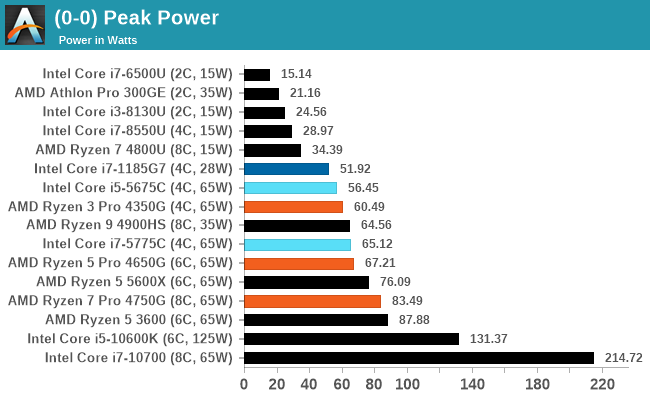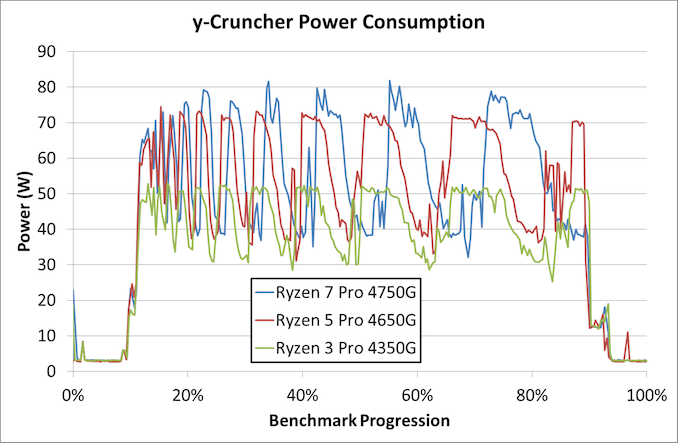Testing The World’s Best APUs: Desktop AMD Ryzen 4750G, 4650G and 4350G
by Dr. Ian Cutress on December 16, 2020 10:30 AM ESTPower Consumption
The nature of reporting processor power consumption has become, in part, a dystopian nightmare. Historically the peak power consumption of a processor, as purchased, is given by its Thermal Design Power (TDP, or PL1). For many markets, such as embedded processors, that value of TDP still signifies the peak power consumption. For the processors we test at AnandTech, either desktop, notebook, or enterprise, this is not always the case.
Modern high performance processors implement a feature called Turbo. This allows, usually for a limited time, a processor to go beyond its rated frequency. Exactly how far the processor goes depends on a few factors, such as the Turbo Power Limit (PL2), whether the peak frequency is hard coded, the thermals, and the power delivery. Turbo can sometimes be very aggressive, allowing power values 2.5x above the rated TDP.
AMD and Intel have different definitions for TDP, but are broadly speaking applied the same. The difference comes to turbo modes, turbo limits, turbo budgets, and how the processors manage that power balance. These topics are 10000-12000 word articles in their own right, and we’ve got a few articles worth reading on the topic.
- Why Intel Processors Draw More Power Than Expected: TDP and Turbo Explained
- Talking TDP, Turbo and Overclocking: An Interview with Intel Fellow Guy Therien
- Reaching for Turbo: Aligning Perception with AMD’s Frequency Metrics
- Intel’s TDP Shenanigans Hurts Everyone
In simple terms, processor manufacturers only ever guarantee two values which are tied together - when all cores are running at base frequency, the processor should be running at or below the TDP rating. All turbo modes and power modes above that are not covered by warranty. Intel kind of screwed this up with the Tiger Lake launch in September 2020, by refusing to define a TDP rating for its new processors, instead going for a range. Obfuscation like this is a frustrating endeavor for press and end-users alike.
However, for our tests in this review, we measure the power consumption of the processor in a variety of different scenarios. These include full AVX2/AVX512 (delete as applicable) workflows, real-world image-model construction, and others as appropriate. These tests are done as comparative models. We also note the peak power recorded in any of our tests.
First up is our image-model construction workload, using our Agisoft Photoscan benchmark. This test has a number of different areas that involve single thread, multi-thread, or memory limited algorithms.
Each of our three processors here seems to approach different steady state power levels for the different areas of the benchmark.
- The 8-core is around 65 W in the first stage, and more around 48 W in the second stage.
- The 6-core is around 51 W in the first stage, and more around 38 W in the second stage.
- The 4-core is around 36 W in the first stage, and more around 30 W in the second stage.
The fact that the difference between each of the processors is 14-15 W in the first stage would go a little to suggesting that we're consuming ~7 W per core in this part of the test, which is strictly multi-threaded. However when it moves more into variable threaded loading, all three CPUs are well below the TDP levels.
The second test is from y-Cruncher, which is our AVX2/AVX512 workload. This also has some memory requirements, which can lead to periodic cycling with systems that have lower memory bandwidth per core options.
The y-Cruncher test is a little different, as we're mostly concerned about peaks. All three CPUs have a TDP rating of 65 W, however the 8-core here breaches 80 W, the 6-core is around 72 W, and the only processor below that TDP value is the quad core Ryzen 3.
For absolute peak power across all of our tests:

For absolute instanteous peak power, each of the Ryzen R4000 APUs does what was expected - with the Ryzen 7 hitting the socket limit for 65 W processors.












104 Comments
View All Comments
CrispySilicon - Wednesday, December 16, 2020 - link
Poor Broadwell. Give it the latest DDR3 and some XMP love, sheesh. Even my 5775C htpc has some damn 1866 ddr3l in it.alufan - Wednesday, December 16, 2020 - link
will this be repeated when the new APUs come out?Ditto others comments re the 720p which is probably a APU sweet spot
lightningz71 - Wednesday, December 16, 2020 - link
I have to agree with other posters; neglecting to include test results for these APUs with overclocked RAM severely reduces the utility of this review. Given the lengths that people will have to go to to acquire these processors, they must have a use case that requires maximum performance of the iGPU, and will more than likely overclock their RAM. For me,if I was sourcing one of these, it would be going into a tiny ITX case with no room for a discreet video card, and would be overclocking my ram to it's limits. Not having at least DDR4-4000 with tight timings does a disservice. And, I would be fine with all the competing desktop APUs having overclocked RAM as well.29a - Thursday, December 17, 2020 - link
Ian claims that not enabling XMP is the more realistic scenario because he thinks that the majority of people who build their own PCs wont go into the BIOS and enable XMP, seriously.lmcd - Friday, December 18, 2020 - link
I haven't on any of my builds until this year and I guarantee most of my friends fell into the same boat. Most build guides don't focus on RAM speed so it's not as common of knowledge.29a - Friday, December 18, 2020 - link
Then you and your friends don't know how to properly build a computer.robbro9 - Wednesday, December 16, 2020 - link
I was really surprised at how well the 2400G/3400G has held up to these newer apus. I was thinking they would be left further behind, but they remain very competitive. Guess it shows that APU wise, AMD has not advanced a whole lot the last few years either.Hoping the next gen zen3 bring a big graphics boost to the table as well. With the mid/low end games I typically play, that would mean no more graphics card purchases for me (unless I wanted a mid life cycle refresh or some such)...
TheinsanegamerN - Wednesday, December 16, 2020 - link
A big part is memory bandwidth. While AMD has improved its not like we have 5000mhz DDR4 feeding these chips. AMD's focus has also been more on efficiency of the GPU as opposed to outright performance.GeoffreyA - Thursday, December 17, 2020 - link
Was surprised myself how well they've held up. Looking forward to seeing Cezanne in action.Cloakstar - Wednesday, December 16, 2020 - link
Try 4 sticks RAM in Bank + Channel Interleave mode. AMD APU gaming performance goes up by 1/3, leaving only 3 of the IGP tests under 30FPS on the 4750G.